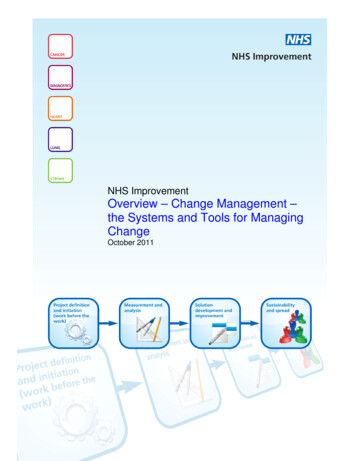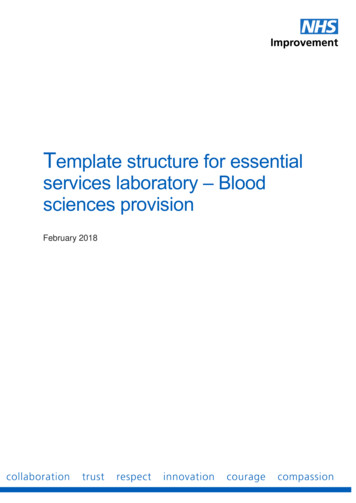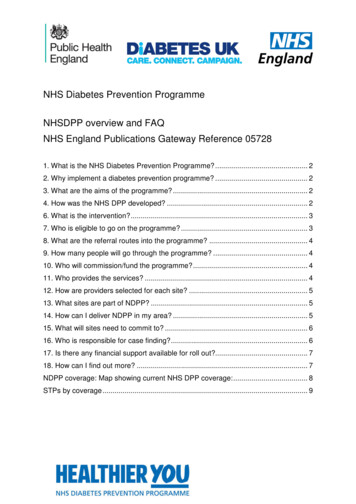
Transcription
NHS ImprovementOverview – Change Management –the Systems and Tools for ManagingChangeOctober 2011
Change management - the Systems and Tools for ManagingChangeScope of change managementChange management processThe change management process is the sequence of steps or activities that a changemanagement team or project leader would follow to apply change management to aproject or change. Based on Prosci's research of the most effective and commonlyapplied change, most change management processes contain the following threephases:Phase 1 - Preparing for change (Preparation, assessment andstrategy development)Phase 2 - Managing change (Detailed planning and changemanagement implementation)Phase 3 - Reinforcing change (Data gathering, correctiveaction and recognition)These phases result in the following approach as shownopposite in Figure 1.rdNHS Improvement, 3 Floor, St Johns House, East Street, Leicester, LE1 6NBOctober 2011
It is important to note what change management is and what change management isnot, as defined by the majority of research participants.Change management is not a stand-alone process for designing a business solution.Change management is the processes, tools and techniques for managing the peopleside of change.Change management is not a process improvement method.Change management is a method for reducing and managing resistance to changewhen implementing process, technology or organizational change.Change management is not a stand-alone technique for improving organizationalperformance.Change management is a necessary component for any organizational performanceimprovement process to succeed, including programs like: Six Sigma, Business ProcessReengineering, Total Quality Management, Organizational Development, Restructuringand continuous process improvement.Change management is about managing change to realize business results.Readiness assessmentsAssessments are tools used by a change management team or project leader to assessthe organization's readiness to change. Readiness assessments can includeorganizational assessments, culture and history assessments, employee assessments,sponsor assessments and change assessments. Each tool provides the project teamwith insights into the challenges and opportunities they may face during the changeprocess. Assess the scope of the change, including: How big is this change? How manypeople are affected? Is it a gradual or radical change?Assess the readiness of the organization impacted by the change, including:What is the value- system and background of the impacted groups? How muchchange is already going on? What type of resistance can be expected?Assess the strengths of your change management team.Assess the change sponsors and take the first steps to enable them to effectivelylead the change process.rdNHS Improvement, 3 Floor, St Johns House, East Street, Leicester, LE1 6NBOctober 2011
Communication and communication planningMany managers assume that if they communicate clearly with their employees, their jobis done. However, there are many reasons why employees may not hear or understandwhat their managers are saying the first time around. In fact, you may have heard thatmessages need to be repeated 6 to 7 times before they are cemented into the minds ofemployees. That is because each employee’s readiness to hear depends on manyfactors. Effective communicators carefully consider three components: the audience,what is said and when it is said.For example, the first step in managing change is building awareness around the needfor change and creating a desire among employees. Therefore, initial communicationsare typically designed to create awareness around the business reasons for change andthe risk of not changing. Likewise, at each step in the process, communications shouldbe designed to share the right messages at the right time.Communication planning, therefore, begins with a careful analysis of the audiences, keymessages and the timing for those messages. The change management team or projectleaders must design a communication plan that addresses the needs of front-lineemployees, supervisors and executives. Each audience has particular needs forinformation based on their role in the implementation of the change.Coaching and manager training for change managementSupervisors will play a key role in managing change. Ultimately, the direct supervisorhas more influence over an employee’s motivation to change than any other person atwork. Unfortunately, supervisors as a group can be the most difficult to convince of theneed for change and can be a source of resistance. It is vital for the changemanagement team and executive sponsors to gain the support of supervisors and tobuild change leadership. Individual change management activities should be used tohelp these supervisors through the change process.Once managers and supervisors are on board, the change management team mustprepare a coaching strategy. They will need to provide training for supervisors includinghow to use individual change management tools with their employees.Training and training developmentTraining is the cornerstone for building knowledge about the change and the requiredskills. Project team members will develop training requirements based on the skills,knowledge and behaviors necessary to implement the change. These trainingrequirements will be the starting point for the training group or the project team todevelop training programs.rdNHS Improvement, 3 Floor, St Johns House, East Street, Leicester, LE1 6NBOctober 2011
Sponsor activities and sponsor roadmapsBusiness leaders and executives play a critical sponsor role in change management.The change management team must develop a plan for sponsor activities and help keybusiness leaders carry out these plans. Sponsorship should be viewed as the mostimportant success factor. Avoid confusing the notion of sponsorship with support. TheCEO of the company may support your project, but that is not the same as sponsoringyour initiative.Sponsorship involves active and visible participation by senior business leadersthroughout the process. Unfortunately many executives do not know what thissponsorship looks like. A change agent's or project leader's role includes helping seniorexecutives do the right things to sponsor the project.Resistance managementResistance from employees and managers is normal. Persistent resistance, however,can threaten a project. The change management team needs to identify, understand andmanage resistance throughout the organization. Resistance management is theprocesses and tools used by managers and executives with the support of the projectteam to manage employee resistance.Data collection, feedback analysis and corrective actionEmployee involvement is a necessary and integral part of managing change. Managingchange is not a one way street. Feedback from employees is a key element of thechange management process. Analysis and corrective action based on this feedbackprovides a robust cycle for implementing change.Celebrating and recognizing successEarly successes and long-term wins must be recognized and celebrated. Individual andgroup recognition is also a necessary component of change management in order tocement and reinforce the change in the organization.The final step in the change management process is the after-action review. It is at thispoint that you can stand back from the entire program, evaluate successes and failures,and identify process changes for the next project. This is part of the ongoing, continuousimprovement of change management for your organization and ultimately leads tochange competency.rdNHS Improvement, 3 Floor, St Johns House, East Street, Leicester, LE1 6NBOctober 2011
SummaryThese eight elements comprise the areas or components of a change management programme.Along with the change management process, they create a system for managing change. Goodproject managers apply these components effectively to ensure project success, avoid the lossof valued employees, and minimize the negative impact of the change on productivity and acompany's customers.rdNHS Improvement, 3 Floor, St Johns House, East Street, Leicester, LE1 6NBOctober 2011
NHS Improvement3rd Floor St Johns HouseEast StreetLeicester LE1 6NBTelephone 0116 222 5253Email: Support@improvement.nhs.ukrdNHS Improvement, 3 Floor, St Johns House, East Street, Leicester, LE1 6NBOctober 2011
NHS Improvement, 3 rd Floor, St Johns House, East Street, Leicester, LE1 6NB October 2011 Change management - the Systems and Tools for Managing Change Scope of change management Change management process The change management process is the sequence of steps or activities that a change










